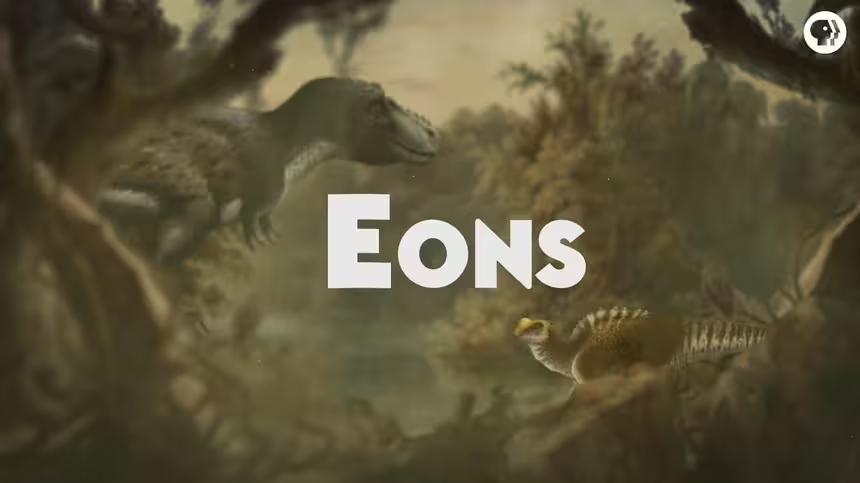
How Ancient Art Captured Australian Megafauna
Season 3 Episode 18 | 9m 43sVideo has Audio Description, Closed Captions
What if the rock art drawings of strange animals really existed?
Beneath layers of rock art are drawings of animals SO strange that, for a long time, some anthropologists thought they could only have been imagined. But what if these animals really had existed, after all?
See all videos with Audio DescriptionADProblems playing video? | Closed Captioning Feedback
Problems playing video? | Closed Captioning Feedback

How Ancient Art Captured Australian Megafauna
Season 3 Episode 18 | 9m 43sVideo has Audio Description, Closed Captions
Beneath layers of rock art are drawings of animals SO strange that, for a long time, some anthropologists thought they could only have been imagined. But what if these animals really had existed, after all?
See all videos with Audio DescriptionADProblems playing video? | Closed Captioning Feedback
How to Watch Eons
Eons is available to stream on pbs.org and the free PBS App, available on iPhone, Apple TV, Android TV, Android smartphones, Amazon Fire TV, Amazon Fire Tablet, Roku, Samsung Smart TV, and Vizio.

Welcome to Eons!
Join hosts Michelle Barboza-Ramirez, Kallie Moore, and Blake de Pastino as they take you on a journey through the history of life on Earth. From the dawn of life in the Archaean Eon through the Mesozoic Era — the so-called “Age of Dinosaurs” -- right up to the end of the most recent Ice Age.Providing Support for PBS.org
Learn Moreabout PBS online sponsorship(host) In the top end of Australia's Northern Territory, there's a rugged area that today is called Arnhem Land.
And it's the homeland of a number of the continent's Aboriginal groups.
It's full of rocky outcrops that sheltered the first people to reach Australia many thousands of years ago.
And they left a fascinating record of drawings on the rock faces there.
This place has more rock art than anywhere else in Australia.
Peek inside any outcrop, and you may just find hundreds or thousands of drawings layered on top of each other, creating a rich visual history of human habitation.
Some of these drawings depict animals that are still around today, like turtles and kangaroos.
More recent drawings include animals that were introduced to Australia, like dingoes and horses.
Beneath these layers are other drawings of animals so strange that for a long time, some anthropologists thought they could only have been imagined.
There are enormous marsupials, giant kangaroos with a single claw on each hind foot, and lion-like creatures.
But what if these animals really existed after all?
What if the drawings made by the original people of Arnhem Land were a faithful record of the wildlife they'd actually seen?
Wildlife that went extinct during the Pleistocene Epoch.
We know that fossilization is a special process that only happens when the conditions are just right.
That means that there are certain environments that might not leave a fossil record.
And even when we find fossils, they can't always give us the full picture of what an organism looked like.
While it's still debated whether the drawings truly represent extinct megafauna, they could be a valuable source of knowledge, one that might help expand our understanding of the Pleistocene fossil record of Australia.
The first people to make it to Australia got there at least 50,000 years ago and possibly as early as 65,000 years ago.
These original inhabitants are thought to have arrived in boats from Asia.
They established their foothold on the continent in rock shelters in northern Arnhem.
It's hard to pinpoint exactly when they began to make rock art, but crayons made of ochre of brownish reddish Earth pigment have been found there that date to around 50,000 years ago.
And there are cave paintings on the Indonesian island of Borneo that are between 52,000 and 40,000 years old.
So the first people to set foot in Australia might have brought a drawing tradition with them from Asia.
The oldest drawing in Arnhem found so far is an X-shaped pictograph made with charcoal.
The scientists were able to radiocarbon date to around 28,000 years ago, but there are still many pictographs that haven't been dated yet.
Now we don't have a lot of fossil evidence to show us what animals the first people in Australia encountered because Arnhem Land has acidic soils, which don't preserve fossils well, as the acid can dissolve bone material.
Because of this, most animal remains found in this area are rarely over 4,000 years old.
But what we do have are the drawings, which provide scientists with some tantalizing insights.
For example, at a site known as the Djulirri Rock Art Complex, there's a picture that at first glance was interpreted as a thylacine.
Thylacines are also called Tasmanian tigers, due to their striped coats, or Tasmanian wolves because they kind of look like wolves.
And they lived alongside people for a long time, until they were eventually pushed to extinction on the Australian mainland.
And when exactly that happened is still being debated.
But a more recent, closer examination of the drawing suggests that it may actually be of the marsupial lion, Thylacoleo .
This depiction had a long head, a short, deep muzzle, and stout jaws.
And these look more like the anatomy of Thylacoleo than the more delicate features of a thylacine.
The only reliable dated Thylacoleo fossils were found in eastern Australia, not in Arnhem Land, with the youngest of those dating to about 40,000 years ago.
And researchers estimate that it went extinct around 30,000 years ago.
So the fossil evidence shows that these marsupial lions survived into a time where they could have overlapped with people for potentially 20,000 years or more.
And if the cave drawing really represents a Thylacoleo , it suggests that people in Arnhem Land might have been familiar with this creature-- hopefully from a distance, as these predators are thought to have been hypercarnivores.
They were about half the size of a modern lion, but relative to body size, they had the largest meat-slicing carnassial teeth known, and a stronger bite force than any other mammalian carnivore.
And while we know that thylacines and Thylacoleo both existed, there are other animals in Arnhem Land pictures that seem to straddle the line between imagination and reality.
Like in another rock art complex called Ubirr, there's a drawing that's clearly a kangaroo, but it doesn't look like any kangaroo alive today.
It has a shorter face, with tufted fur sticking up from its ears, and a single large claw on each back foot.
Its tail is thick along its entire length, not tapering like a modern kangaroos.
And it also has a level of anatomical accuracy that suggests it really existed, like the animal's, uh, testes hanging just below the base of the tail.
But little attention was paid by anthropologists to this drawing for many years.
Even though it was the biggest animal depicted on the rock, it was obscured under layers of more recent drawings.
Paleontologists now think it was a Procoptodon goliah , an extinct species of short-faced kangaroo that had a large, single-clawed toe on each hind foot, And it was over 2 1/2 times as heavy as a modern red kangaroo.
Again, reliably dated fossils of this creature have not been found in Arnhem Land.
However, fossils have been uncovered at many sites concentrated in southeast Australia, where conditions are more conducive to fossilization.
The youngest fossils of Procoptodon goliah are dated to 46,000 years ago.
So these fossils are young enough that this massive kangaroo may have lived among the people of Arnhem Land.
In fact, some Australian Aboriginal oral traditions include accounts of a huge, aggressive kangaroo that attacked people with its long arms.
There were a number of short-faced kangaroo species living in Pleistocene Australia, with jaws adapted for grinding up tough leaves.
But Procoptodon goliah was the largest of this particular group.
And since it was at least 230 kilograms, this mammal was probably too heavy to hop.
Instead, anatomical studies show that it was adapted to stride, shifting its weight from leg to leg, kind of like we do.
So, a marsupial lion with a super bite.
A striding attack kangaroo.
What else might the first people in Arnhem Land have seen and recorded as part of their environment in Australia?
Well, they might have also encountered the largest marsupial to ever live.
Recent analysis by paleontologists have identified a possible Diprotodon represented in the rock art of Arnhem.
Diprotodon was 1.8 meters tall at the shoulder, almost four meters long, and approaching 2,800 kilograms, taking the prize for the most mega of the megafauna of Australia, as its largest mammal ever.
Like other megafauna, Diprotodon left no fossils to prove its existence in Northern Australia.
But based on variation in the isotope signatures of its incisors, researchers think they migrated.
As a bulky, migratory herbivore, Diprotodon filled the role in Pleistocene Australia that mammoths and mastodons filled elsewhere, only it was a marsupial.
So it's possible the people of Arnhem Land would have encountered it as it wandered across Australia.
Diprotodon fossils suggest it went extinct around 25,000 years ago, giving it one of the longest overlaps with people.
So what happened to all of these odd creatures that existed at the same time and maybe even crossed paths with the first people of Australia?
Well, Australia got a lot warmer and drier leading up to about 50,000 years ago.
Water became scarce, and inland lakes shrunk or disappeared, changes that might have contributed to the extinction of the megafauna.
But the exact timing of their extinction is still an open question.
And bringing together the two lines of evidence, art and fossils, can help us better understand the past, especially when the fossils are absent.
Fossils can prove that many strange creatures that are now extinct once really did exist.
While cave paintings and rock art can help mark their distribution over the landscape, including in areas with poor fossil preservation.
The art may also help us understand variation within a species and reveal things, like coat color and soft tissue anatomy, that usually aren't preserved.
What is now clear is that large creatures lived in Australia during the Pleistocene, and some of them very likely overlapped with the first people on the continent.
Today we see more modestly-sized survivors, like wombats, koalas, and red kangaroos that are still around.
But in the layers of rock art, we can see the landscape of the past.
It's a record that can add rich detail to our understanding of the megafauna that once existed, uniting traditional knowledge of the environment with modern paleontology to shed light on Australia's unique megafauna.
Accessibility provided by the U.S. Department of Education.
♪


- Science and Nature

A documentary series capturing the resilient work of female land stewards across the United States.












Support for PBS provided by:

